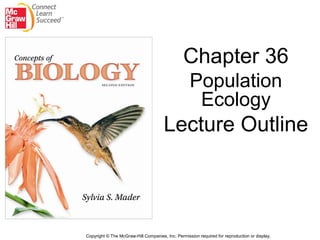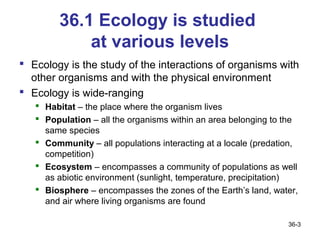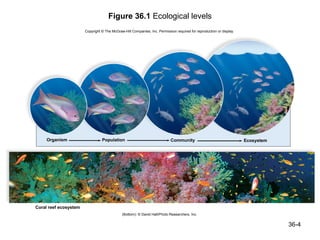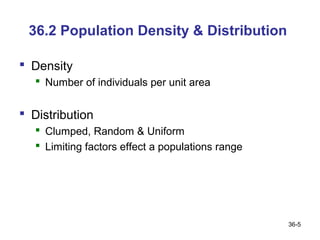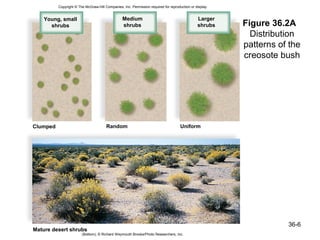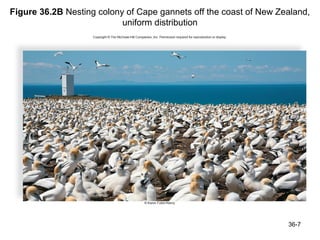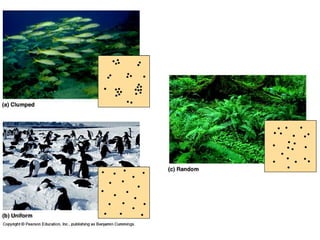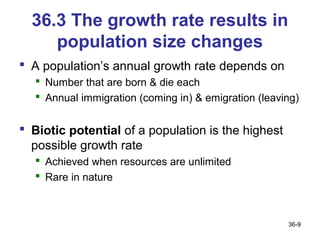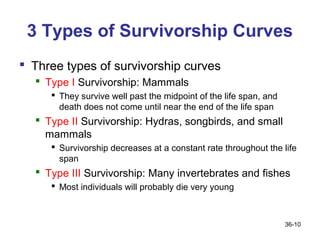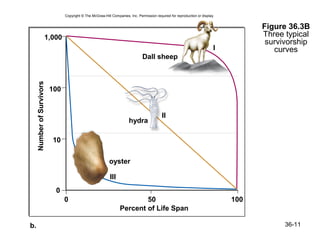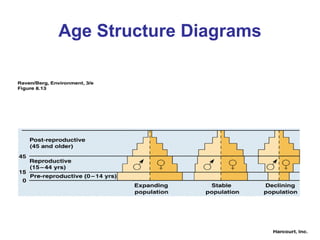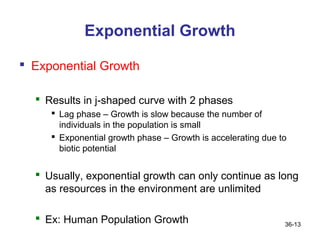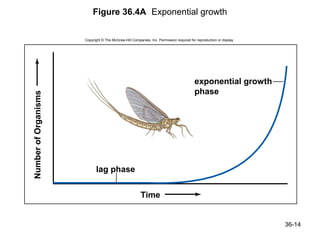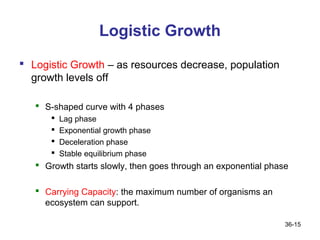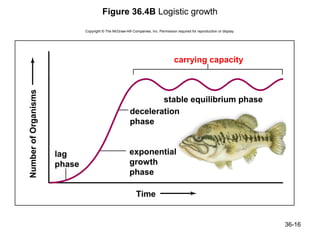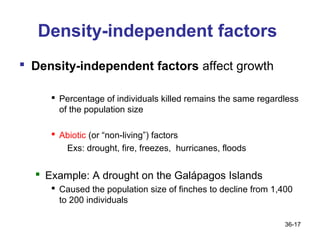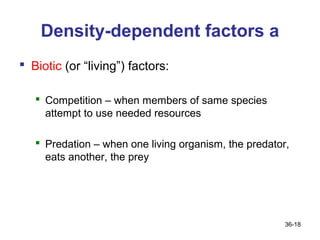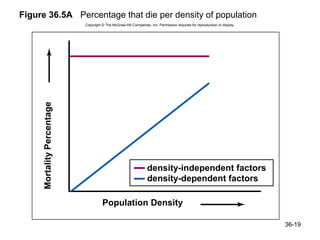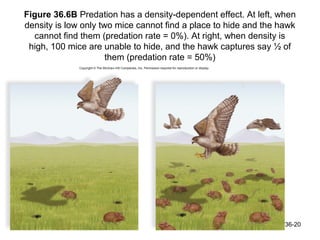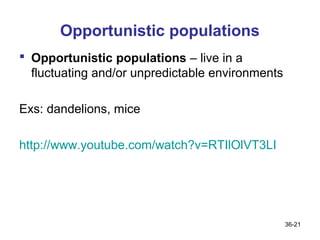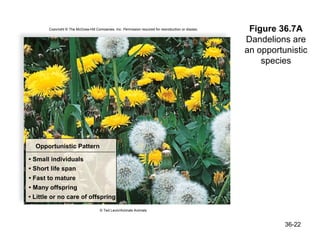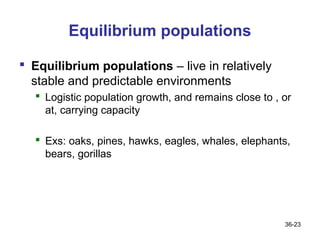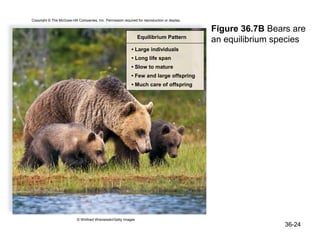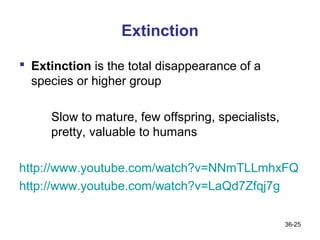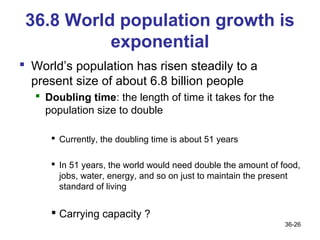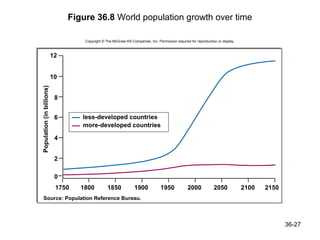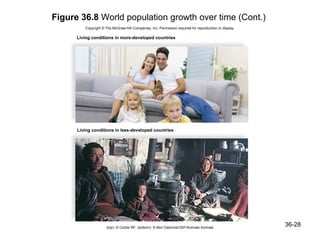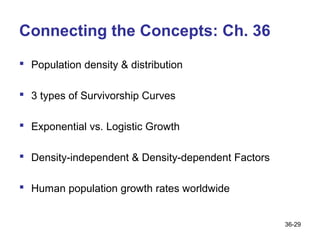Bio 100 Chapter 36
- 1. Chapter 36 Population Ecology Lecture Outline Copyright ÂĐ The McGraw-Hill Companies, Inc. Permission required for reproduction or display.
- 3. 36.1 Ecology is studied at various levels ï§ Ecology is the study of the interactions of organisms with other organisms and with the physical environment ï§ Ecology is wide-ranging ï§ Habitat â the place where the organism lives ï§ Population â all the organisms within an area belonging to the same species ï§ Community â all populations interacting at a locale (predation, competition) ï§ Ecosystem â encompasses a community of populations as well as abiotic environment (sunlight, temperature, precipitation) ï§ Biosphere â encompasses the zones of the Earthâs land, water, and air where living organisms are found 36-3
- 4. Figure 36.1 Ecological levels Copyright ÂĐ The McGraw-Hill Companies, Inc. Permission required for reproduction or display. Organism Population Community Ecosystem Coral reef ecosystem (Bottom): ÂĐ David Hall/Photo Researchers, Inc. 36-4
- 5. 36.2 Population Density & Distribution ï§ Density ï§ Number of individuals per unit area ï§ Distribution ï§ Clumped, Random & Uniform ï§ Limiting factors effect a populations range 36-5
- 6. Copyright ÂĐ The McGraw-Hill Companies, Inc. Permission required for reproduction or display. Young, small Medium Larger shrubs shrubs shrubs Figure 36.2Aâ Distribution patterns of the creosote bush Clumped Random Uniform 36-6 Mature desert shrubs (Bottom); ÂĐ Richard Weymouth Brooks/Photo Researchers, Inc.
- 7. Figure 36.2B Nesting colony of Cape gannets off the coast of New Zealand, uniform distribution 36-7
- 9. 36.3 The growth rate results in population size changes ï§ A populationâs annual growth rate depends on ï§ Number that are born & die each ï§ Annual immigration (coming in) & emigration (leaving) ï§ Biotic potential of a population is the highest possible growth rate ï§ Achieved when resources are unlimited ï§ Rare in nature 36-9
- 10. 3 Types of Survivorship Curves ï§ Three types of survivorship curves ï§ Type I Survivorship: Mammals ï§ They survive well past the midpoint of the life span, and death does not come until near the end of the life span ï§ Type II Survivorship: Hydras, songbirds, and small mammals ï§ Survivorship decreases at a constant rate throughout the life span ï§ Type III Survivorship: Many invertebrates and fishes ï§ Most individuals will probably die very young 36-10
- 11. Copyright ÂĐ The McGraw-Hill Companies, Inc. Permission required for reproduction or display. Figure 36.3B 1,000 Three typical survivorship I curves Dall sheep Number of Survivors 100 II hydra 10 oyster III 0 0 50 100 Percent of Life Span b. 36-11
- 13. Exponential Growth ï§ Exponential Growth ï§ Results in j-shaped curve with 2 phases ï§ Lag phase â Growth is slow because the number of individuals in the population is small ï§ Exponential growth phase â Growth is accelerating due to biotic potential ï§ Usually, exponential growth can only continue as long as resources in the environment are unlimited ï§ Ex: Human Population Growth 36-13
- 14. Figure 36.4AâExponential growth Copyright ÂĐ The McGraw-Hill Companies, Inc. Permission required for reproduction or display. exponential growth phase Number of Organisms lag phase Time 36-14
- 15. Logistic Growth ï§ Logistic Growth â as resources decrease, population growth levels off ï§ S-shaped curve with 4 phases ï§ Lag phase ï§ Exponential growth phase ï§ Deceleration phase ï§ Stable equilibrium phase ï§ Growth starts slowly, then goes through an exponential phase ï§ Carrying Capacity: the maximum number of organisms an ecosystem can support. 36-15
- 16. Figure 36.4B Logistic growth Copyright ÂĐ The McGraw-Hill Companies, Inc. Permission required for reproduction or display. carrying capacity Number of Organisms stable equilibrium phase deceleration phase lag exponential phase growth phase Time 36-16
- 17. Density-independent factors ï§ Density-independent factors affect growth ï§ Percentage of individuals killed remains the same regardless of the population size ï§ Abiotic (or ânon-livingâ) factors Exs: drought, fire, freezes, hurricanes, floods ï§ Example: A drought on the GalÃĄpagos Islands ï§ Caused the population size of finches to decline from 1,400 to 200 individuals 36-17
- 18. Density-dependent factors a ï§ Biotic (or âlivingâ) factors: ï§ Competition â when members of same species attempt to use needed resources ï§ Predation â when one living organism, the predator, eats another, the prey 36-18
- 19. Figure 36.5Aâ Percentage that die per density of population Copyright ÂĐ The McGraw-Hill Companies, Inc. Permission required for reproduction or display. Mortality Percentage density-independent factors density-dependent factors Population Density 36-19
- 20. Figure 36.6B Predation has a density-dependent effect. At left, when density is low only two mice cannot find a place to hide and the hawk cannot find them (predation rate = 0%). At right, when density is high, 100 mice are unable to hide, and the hawk captures say Â― of them (predation rate = 50%) 36-20
- 21. Opportunistic populations ï§ Opportunistic populations â live in a fluctuating and/or unpredictable environments Exs: dandelions, mice http://www.youtube.com/watch?v=RTIlOlVT3LI 36-21
- 22. Copyright ÂĐ The McGraw-Hill Companies, Inc. Permission required for reproduction or display. Figure 36.7A Dandelions are an opportunistic species Opportunistic Pattern âĒ Small individuals âĒ Short life span âĒ Fast to mature âĒ Many offspring âĒ Little or no care of offspring ÂĐ Ted Levin/Animals Animals 36-22
- 23. Equilibrium populations ï§ Equilibrium populations â live in relatively stable and predictable environments ï§ Logistic population growth, and remains close to , or at, carrying capacity ï§ Exs: oaks, pines, hawks, eagles, whales, elephants, bears, gorillas 36-23
- 24. Copyright ÂĐ The McGraw-Hill Companies, Inc. Permission required for reproduction or display. Figure 36.7B Bears are Equilibrium Pattern an equilibrium species âĒ Large individuals âĒ Long life span âĒ Slow to mature âĒ Few and large offspring âĒ Much care of offspring ÂĐ Winfried Wisniewski/Getty Images 36-24
- 25. Extinction ï§ Extinction is the total disappearance of a species or higher group Slow to mature, few offspring, specialists, pretty, valuable to humans http://www.youtube.com/watch?v=NNmTLLmhxFQ http://www.youtube.com/watch?v=LaQd7Zfqj7g 36-25
- 26. 36.8 World population growth is exponential ï§ Worldâs population has risen steadily to a present size of about 6.8 billion people ï§ Doubling time: the length of time it takes for the population size to double ï§ Currently, the doubling time is about 51 years ï§ In 51 years, the world would need double the amount of food, jobs, water, energy, and so on just to maintain the present standard of living ï§ Carrying capacity ? 36-26
- 27. Figure 36.8 World population growth over time Copyright ÂĐ The McGraw-Hill Companies, Inc. Permission required for reproduction or display. 12 10 Population (in billions) 8 6 less-developed countries more-developed countries 4 2 0 1750 1800 1850 1900 1950 2000 2050 2100 2150 Source: Population Reference Bureau. 36-27
- 28. Figure 36.8 World population growth over time (Cont.) Copyright ÂĐ The McGraw-Hill Companies, Inc. Permission required for reproduction or display. Living conditions in more-developed countries Living conditions in less-developed countries (top): ÂĐ Corbis RF; (bottom): ÂĐ Ben Osborne/OSF/Animals Animals 36-28
- 29. Connecting the Concepts: Ch. 36 ï§ Population density & distribution ï§ 3 types of Survivorship Curves ï§ Exponential vs. Logistic Growth ï§ Density-independent & Density-dependent Factors ï§ Human population growth rates worldwide 36-29
